9 Herbal Teas For Joint Pain

Herbal teas have been a go-to remedy for joint pain for centuries, and it's easy to see why.
These teas work by reducing inflammation, which is often the root cause of joint pain. For example, Curcuma longa, also known as turmeric, contains a powerful compound called curcumin, which has potent anti-inflammatory properties. When consumed as a tea, curcumin can help alleviate joint pain and stiffness. Another herb that's great for joint pain relief is Zingiber officinale, or ginger. Ginger has anti-inflammatory compounds called gingerols and shogaols, which can help reduce swelling and pain in the joints. Drinking ginger tea can also help improve circulation, which can aid in the delivery of oxygen and nutrients to the joints.
Ginkgo biloba is another herb that's often used to relieve joint pain. The leaves of the ginkgo biloba tree contain flavonoids and terpenoids, which have anti-inflammatory and antioxidant properties. These compounds can help reduce pain and inflammation in the joints, and also improve circulation and flexibility. Drinking herbal teas for joint pain can be incredibly beneficial. Not only can they help alleviate pain and stiffness, but they can also improve overall mobility and flexibility. This can make everyday activities, like walking or climbing stairs, much easier and more manageable. Additionally, herbal teas can help reduce the need for pain medication, which can have negative side effects when taken long-term.
By incorporating herbal teas into your daily routine, you can take a natural and effective approach to managing joint pain.
- 1. Curcuma longa
- 2. Zingiber officinale
- 3. Ginkgo biloba
- 4. Salix alba
- 5. Sambucus nigra
- 6. Glycyrrhiza glabra
- 7. Achillea millefolium
- 8. Cinchona officinalis
- 9. Urtica dioica
1. Curcuma longa
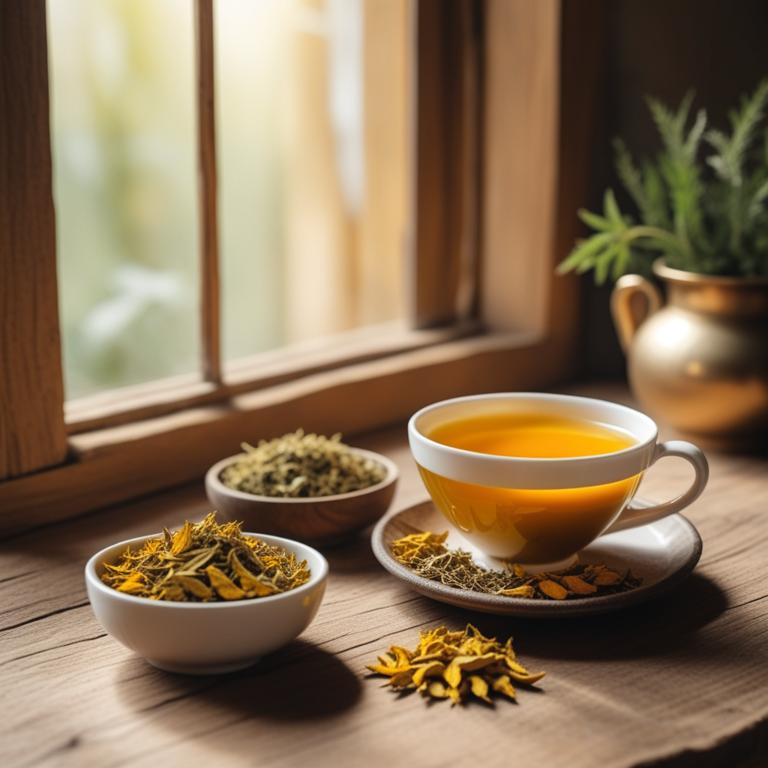
Curcuma longa teas contains a compound called curcumin, which has potent anti-inflammatory and antioxidant properties.
Curcumin works by blocking an enzyme called COX-2, which causes inflammation and pain in joints. It also has a compound called demethoxycurcumin, which has strong anti-inflammatory effects and helps to reduce joint pain and swelling. Curcuma longa teas also contains a compound called bisdemethoxycurcumin, which has antioxidant properties that help to protect joints from damage and promote healing.
The combination of these compounds makes Curcuma longa teas a potential natural remedy for managing joint pain and inflammation.
- Gather ingredients: 1 teaspoon of dried Curcuma longa root powder, 1 cup of boiling water, and a strainer.
- Add 1 teaspoon of Curcuma longa root powder to a cup.
- Pour 1 cup of boiling water over the powder.
- Steep for 5-7 minutes to allow the powder to infuse.
- Strain the liquid and drink as a tea, 1-3 times a day for joint pain relief.
2. Zingiber officinale
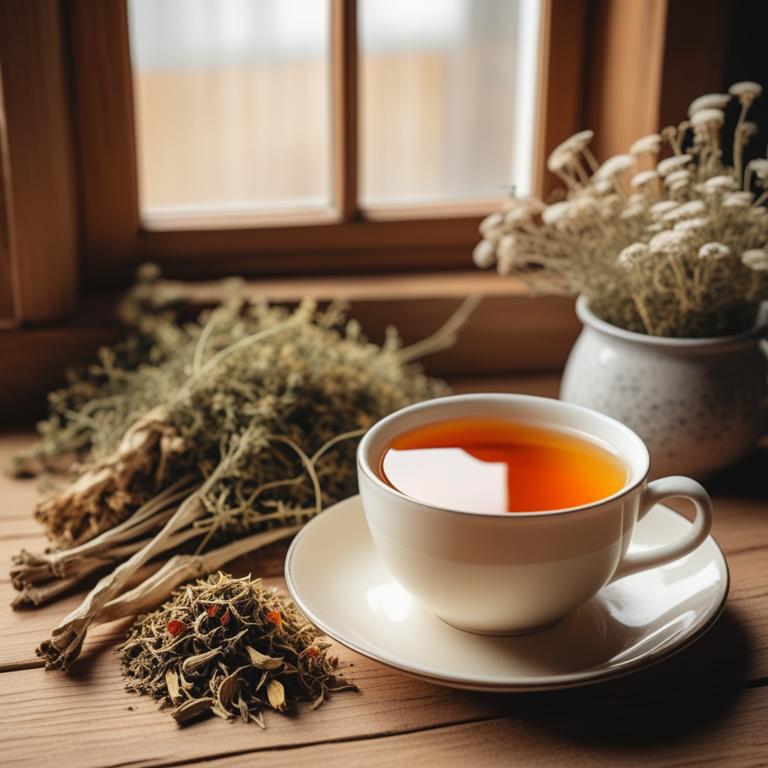
Zingiber officinale teas contains compounds like gingerol and shogaol, which have anti-inflammatory properties.
These properties help reduce swelling and pain in the joints, making it easier to move around. The anti-inflammatory effect is also due to the presence of zingerone, a compound that blocks the production of pro-inflammatory molecules. Gingerols and shogaols also have antioxidant properties, which help protect the joints from damage caused by free radicals.
By reducing inflammation and protecting the joints, Zingiber officinale teas can help alleviate joint pain and discomfort.
- Gather 1 teaspoon of dried ginger root (Zingiber officinale) and 1 cup of boiling water.
- Steep the ginger root in the boiling water for 5-7 minutes.
- Strain the liquid and discard the ginger root.
- Add 1 tablespoon of honey (optional) to the ginger tea, if desired.
- Drink the ginger tea warm or at room temperature, 2-3 times a day for relief from joint pain.
Zingiber Officinale Tea on Amazon
FGO Organic Ginger Tea, 100 Count, Eco-Conscious Tea Bags, Caffeine Free, Packaging May Vary (Pack of 1)
Disclaimer: We earn a commission if you click this link and make a purchase at no additional cost to you.
3. Ginkgo biloba
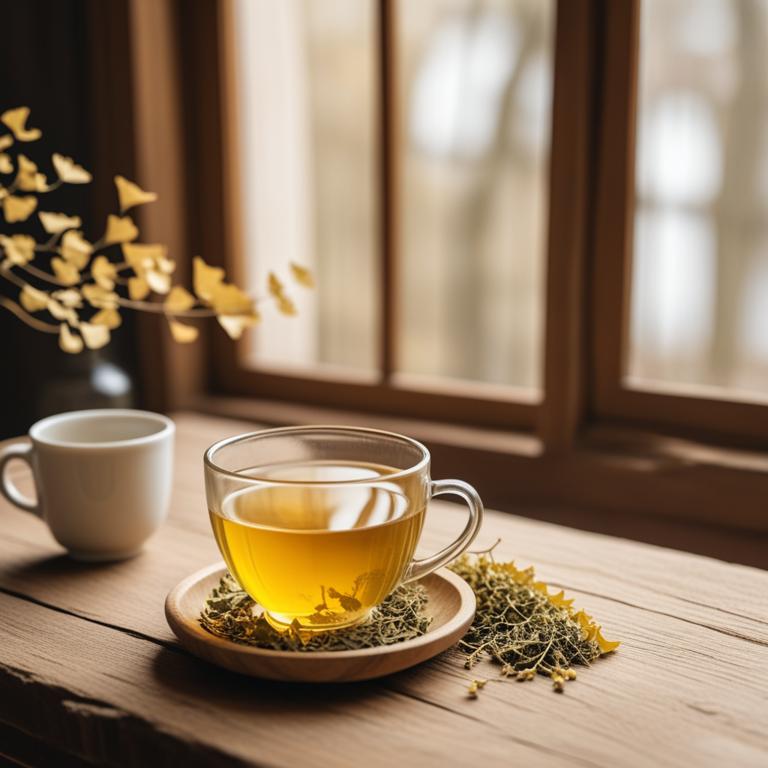
Ginkgo biloba teas contains bioactive constituents like flavonoids, terpenoids, and bilobalide, which contribute to its potential benefits for joint pain.
The flavonoids in Ginkgo biloba have anti-inflammatory properties, which help reduce swelling and pain in the joints. Bilobalide, on the other hand, has a protective effect on the nerves and blood vessels, improving circulation and reducing stiffness in the joints. Terpenoids in Ginkgo biloba also have anti-inflammatory properties, which help to reduce inflammation and pain in the joints.
By reducing inflammation and improving circulation, Ginkgo biloba teas may help alleviate joint pain and promote overall joint health.
- Gather 2 teaspoons of dried Ginkgo biloba leaves.
- Boil 1 cup of water in a tea kettle.
- Add 2 teaspoons of dried Ginkgo biloba leaves to a tea infuser.
- Pour the boiling water over the Ginkgo biloba leaves and let it steep for 5-7 minutes.
- Strain the tea and drink 1 cup, 2-3 times a day for joint pain relief.
4. Salix alba

Salix alba teas contains salicin, a compound similar to aspirin, which helps reduce inflammation and pain in joints.
The flavonoids in Salix alba teas, such as quercetin and kaempferol, have anti-inflammatory and antioxidant properties that also contribute to pain relief. Salicin in Salix alba teas is converted into salicylic acid in the body, which blocks the production of prostaglandins, hormone-like substances that cause pain and inflammation. This process helps alleviate joint pain and stiffness.
Regular consumption of Salix alba teas may also improve blood flow and reduce oxidative stress, further alleviating joint pain.
- Gather 1 cup of dried Salix alba bark or 2 cups of fresh Salix alba bark.
- Measure 1 tablespoon of the gathered Salix alba bark and add it to 1 cup of boiling water.
- Reduce the heat and let it simmer for 5-7 minutes, then cover the cup.
- Strain the liquid through a cheesecloth or a coffee filter into another cup.
- Drink the tea 2-3 times a day, ideally 30 minutes before meals, to help with joint pain.
5. Sambucus nigra
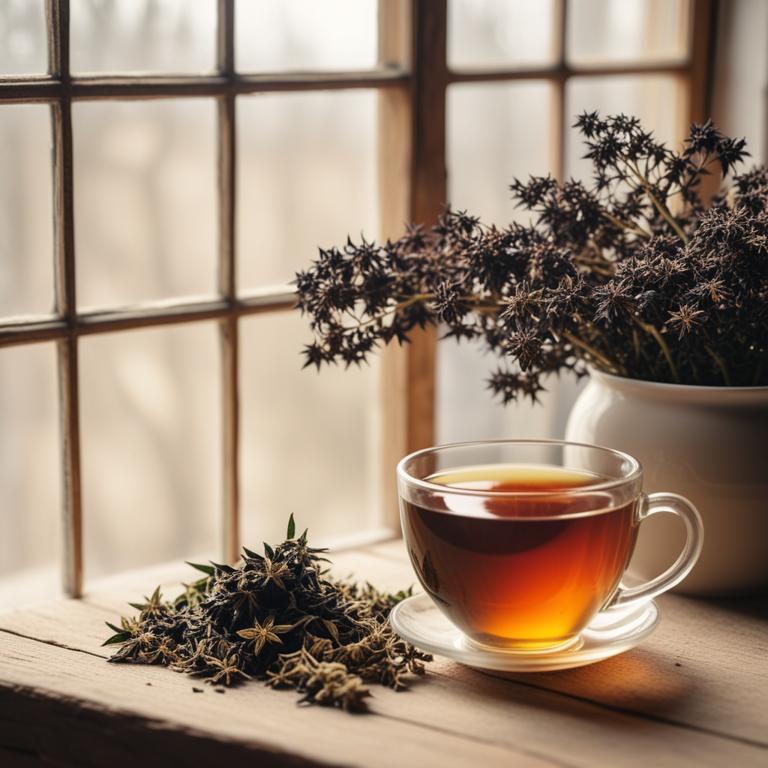
Sambucus nigra teas contains bioactive constituents like flavonoids, alkaloids, and glycosides, which have anti-inflammatory properties.
These compounds help reduce inflammation and pain in the joints by inhibiting the production of pro-inflammatory enzymes. The flavonoids present in the tea, such as quercetin and kaempferol, also have antioxidant properties that help protect the joints from oxidative stress. The glycosides in Sambucus nigra, like sambunigrin, have been shown to have analgesic and anti-inflammatory effects, making it a potential remedy for joint pain.
Regular consumption of Sambucus nigra tea may help alleviate joint pain and discomfort by reducing inflammation and promoting overall joint health.
- Gather 1 cup of fresh Sambucus nigra flowers, 1 cup of boiling water, and a strainer.
- Steep the Sambucus nigra flowers in the boiling water for 5-7 minutes.
- Strain the mixture through a cheesecloth or a fine-mesh strainer to remove the flowers.
- Combine 1 tablespoon of honey with the strained tea to taste. You can add more if needed.
- Drink 1-2 cups of the tea per day to help with joint pain. You can store the tea in the fridge for up to 24 hours.
6. Glycyrrhiza glabra
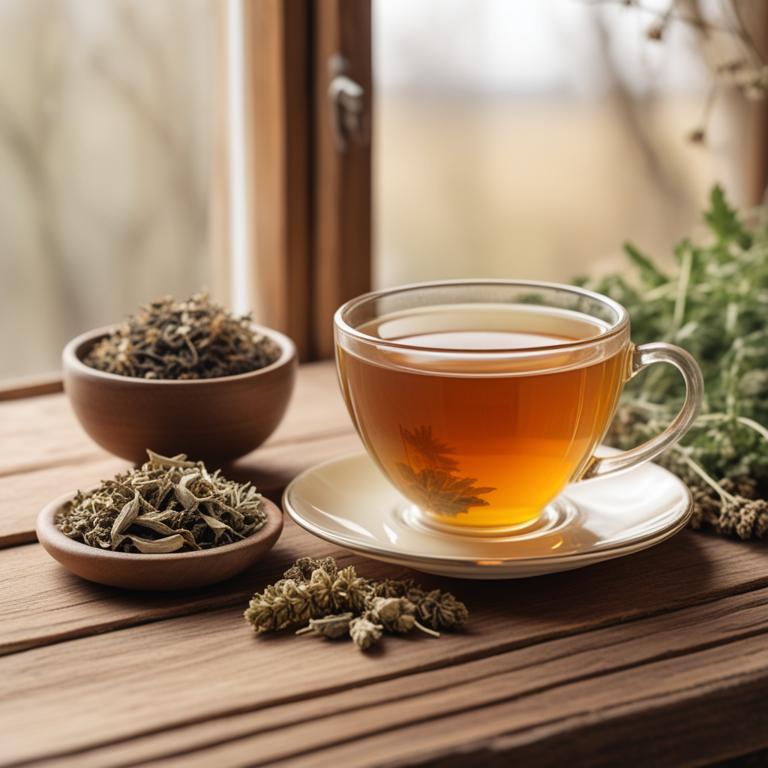
Glycyrrhiza glabra teas contains triterpenoid saponins, particularly glycyrrhizin, which is responsible for its medicinal properties.
Glycyrrhizin has anti-inflammatory and anti-arthritic effects, making it effective in reducing joint pain and swelling. It also has a glucocorticoid-like effect, which helps to reduce inflammation and relieve joint pain. The saponins in Glycyrrhiza glabra teas also have antioxidant properties, which help to protect the joints from oxidative damage and promote healing.
By reducing inflammation and promoting healing, Glycyrrhiza glabra teas can help to alleviate joint pain and improve joint function.
- Gather 1 cup of dried Glycyrrhiza glabra roots. You can find them in health food stores or online.
- Measure 1 tablespoon of dried roots and place them in a tea infuser or a small muslin bag.
- Boil 1 cup of water in a pot. Remove from heat and let it cool for 1-2 minutes.
- Pour the hot water over the tea infuser or muslin bag containing the Glycyrrhiza glabra roots. Let it steep for 5-7 minutes.
- Strain the tea into a cup and discard the roots. You can drink 1-2 cups of this tea per day to help with joint pain.
7. Achillea millefolium

Achillea millefolium teas contains a variety of bioactive constituents, including sesquiterpene lactones, flavonoids, and phenolic acids.
These compounds have anti-inflammatory and antioxidant properties, which can help reduce joint pain and inflammation. The sesquiterpene lactones, particularly 11,13-dihydrochrysoplenolone, have been shown to inhibit the production of pro-inflammatory enzymes, such as COX-2 and LOX. The flavonoids and phenolic acids in the tea have antioxidant properties, which can help neutralize free radicals and reduce oxidative stress in the joints.
By reducing inflammation and oxidative stress, Achillea millefolium teas may provide relief for people suffering from joint pain.
- Gather 1 cup of fresh Achillea millefolium leaves and flowers, or 1 teaspoon of dried ones.
- Combine the gathered leaves and flowers with 1 cup of boiling water in a teapot or cup.
- Steep for 5-7 minutes, then strain the liquid into another cup using a tea strainer.
- Add 1 tablespoon of honey or lemon juice to taste, if desired.
- Drink 1-2 cups of the tea per day to help alleviate joint pain.
8. Cinchona officinalis

Cinchona officinalis teas contains a valuable compound called quinine, which has anti-inflammatory properties that help reduce joint pain.
Quinine works by blocking the production of pro-inflammatory chemicals in the body, such as prostaglandins and leukotrienes, which contribute to joint pain and swelling. Another important compound in Cinchona officinalis is alkaloid, specifically cinchonine, which has antiseptic and anti-inflammatory properties that help soothe and calm joint inflammation. Additionally, Cinchona officinalis contains flavonoids, like quercetin, which have antioxidant properties that help reduce oxidative stress and inflammation in the joints.
By reducing inflammation and oxidative stress, Cinchona officinalis teas may help alleviate joint pain and improve joint function.
- Gather 2 tablespoons of dried Cinchona officinalis bark and 1 cup of boiling water.
- Steep the bark in the boiling water for 5-7 minutes, then strain it into a cup.
- Add 1 tablespoon of honey to the tea, if desired, for a sweeter taste.
- Drink the tea 2-3 times a day, ideally after meals, to help manage joint pain.
- Consult with a healthcare professional before using Cinchona officinalis tea as a treatment for joint pain.
9. Urtica dioica

Urtica dioica teas contains bioactive constituents like histamine, polysaccharides, and flavonoids.
Histamine has anti-inflammatory properties that help reduce swelling and pain in joints. Polysaccharides, particularly rhamnogalacturonan I, have been shown to inhibit the production of inflammatory enzymes and cytokines. Flavonoids, such as quercetin and kaempferol, have potent antioxidant and anti-inflammatory effects, which can help alleviate joint pain and inflammation.
The combination of these bioactive compounds in Urtica dioica teas may help provide relief from joint pain by reducing inflammation and oxidative stress.
- Gather 1 cup of fresh Urtica dioica leaves or 2 tablespoons of dried leaves.
- Combine the Urtica dioica leaves with 1 cup of boiling water in a teapot.
- Steep the mixture for 5-7 minutes, then strain it into a cup.
- Add 1 tablespoon of honey or lemon to taste, if needed.
- Drink the tea 2-3 times a day for joint pain relief.